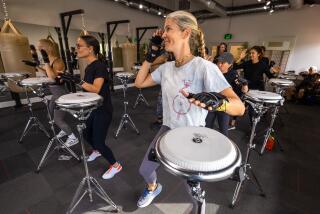Whole lotta shakin’ going on, but is it safe?
- Share via
There’s some new buzz on vibrating exercise platforms.
The machines, which are cropping up with increasing frequency in gyms and exercise rooms, are used during workouts. They’re based on the theory that vibrating the body like a giant tuning fork will strengthen muscles, increase flexibility and build bone.
Some research suggests the machines may provide moderate benefits, but researchers at the Johnson Space Center in Houston have found that the machines also may exceed occupational safety standards for vibrating equipment such as trucks and heavy machinery.
The investigators attached accelerometers and motion trackers to the vibration platforms and to the legs, torso and head of 16 subjects and measured the direction and magnitude of vibration experienced by the subjects as they performed partial squats. Subjects were exposed to 15-second bouts of 30 one-cycle-per-second (or hertz) vibration -- a common setting for these machines.
The nine men and seven women were tested on a Power Plate, which does an up-and-down type of vibration, and a Galileo 2000, which does a rotational vibration, pushing one foot up and then the other.
The researchers found that 10 minutes of vibration on the machines exceeded the recommended daily whole-body vibration exposure as defined by the ISO, or International Organization for Standardization.
Chronic exposure to whole-body vibration, such as that experienced by operators of tractors and helicopters, has been associated with injury to the spine, osteoarthritis, visual impairment and damage to the vestibular system.
The ISO standards for vibration were developed by a worldwide network of national standards institutes. These institutes cull data from teams of scientists, academics and equipment manufacturers, according to Paul Schomer, standards director for the Acoustical Society of America, the accredited U.S. representative to the ISO for acoustics and vibration. The upper limit for occupational vibration (ISO 2631-1) is arrived at by consensus and voted on by member institutes.
The authors of the study caution that applying ISO standards to vibrating exercise equipment may not be entirely fair, and proponents of vibration training agree.
“Vibration training is carried out in a controlled environment, with the body in alignment and doing what the body is designed to do,” says Scott Hopson, director of research, education and training for Power Plate.
“It’s not the same as randomly applying vibration to the passive body,” such as occurs when driving a truck, he says, in which an inconsistent vibration is passing through a passive, seated body, and presumably jarring the body in a nonuniform way.
Vibrating exercise machines should not be confused with much less aggressive vibration machines that are sometimes used for the treatment of osteoporosis and other musculoskeletal problems, says Dr. Clifford Rosen, an osteoporosis clinician and researcher at the Maine Medical Center Research Institute in Scarborough.
“These other machines, the exercise machines, have a really high magnitude of vibration,” says Rosen, “so you’re shaking much harder.”
--






